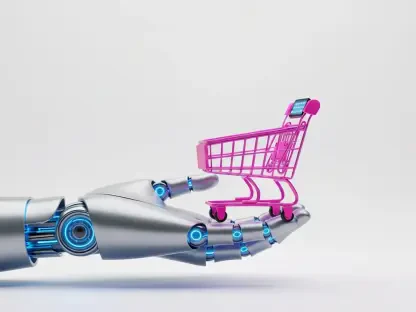In a bold move defining the future of corporate structures, Amazon is embracing artificial intelligence with unprecedented depth and breadth. The company has recently announced a strategic decision to substantially integrate generative AI into its operations, aligning with a broader industry trend that sees technology as the catalyst for transformation. CEO Andy Jassy has been vocal about the pivotal role these AI tools will play, particularly in enhancing efficiency across multiple sectors, including customer service, inventory management, and other essential internal processes. This ambitious endeavor aims not only to innovate traditional business operations but also to transform the very contours of Amazon’s workforce dynamics. With the implementation of countless AI tools, particularly those with generative capabilities, Amazon is set to streamline routine tasks, create new roles, and consequently render several existing positions obsolete. While this might reflect the broader challenges posed by automation, it also highlights an opportunity for businesses to optimize their efficiency and operational productivity.
Transforming Operational Efficiency with AI
The integration of AI into Amazon’s operational landscape is expected to revolutionize customer service and inventory management. By using AI tools to automate routine and time-consuming tasks, Amazon aims to free up employees from mundane duties, allowing them to focus on more strategic, high-impact activities. AI-driven chatbots and customer service applications enable seamless interaction by addressing common queries and facilitating a more personalized shopping experience. In inventory management, AI algorithms predict demand, optimize stock levels, and enhance supply chain processes, minimizing waste and reducing operational costs. This efficiency not only benefits Amazon’s bottom line but also sets a new benchmark in the industry for harnessing AI to refine business processes. The commitment to leveraging AI demonstrates Amazon’s proactive stance in adapting to technological advancements and reflects a broader industry inclination toward digital transformation. As companies increasingly adopt AI, competitive advantage will belong to those who can effectively utilize these technologies to optimize their operations.
Moreover, this shift towards AI-powered operations underscores Amazon’s strategic focus on fostering innovation and agility. By encouraging employees to engage with AI technologies and attend dedicated training sessions, Amazon positions itself as a leader in AI integration. Staff are equipped with the necessary skills to adapt to these changing environments, ensuring they remain relevant in a rapidly evolving digital landscape. As an organization, Amazon recognizes the importance of balancing innovation with human expertise, creating a collaborative ecosystem where technology and human talent intersect. This not only enhances operational efficiency but also fosters a culture of continuous learning and improvement. In doing so, Amazon reinforces its commitment to excellence and positions itself as a trailblazer in the realm of AI-driven transformation.
Implications for Workforce Dynamics
The integration of AI also signifies a pivotal shift in Amazon’s workforce dynamics, with generative AI tools reshaping job roles and creating new opportunities. While certain positions may become redundant due to automation, Amazon anticipates a surge in demand for roles related to AI development and oversight. Employees are encouraged to engage with these AI technologies, enhancing their skillsets and contributing to Amazon’s evolving initiatives. This transition reflects a nuanced understanding of AI’s potential, balancing innovation and efficiency with evolving workforce demands. The development of generative AI agents designed to support complex tasks like code writing, research summarization, and insight generation illustrates this potential. As AI capabilities expand, new jobs emerge that require specialized skills in AI system management, software development, and data analysis.
The strategic focus on AI integration demonstrates Amazon’s dedication to transforming its workforce to align with future demands. Employees are encouraged to adapt and evolve, positioning themselves to take advantage of the new roles stimulated by AI. As the demand for skills like AI development and management rises, Amazon understands the need for a workforce that can proficiently engage with these technologies. The organization’s efforts to cultivate a skilled workforce capable of navigating the complexities of AI integration not only enhance individual career prospects but also position Amazon at the forefront of industry innovation. By fostering a forward-thinking environment, Amazon underscores its commitment to driving progress and remaining economic leaders in the tech landscape.
AI’s Role in Industry-Wide Trends
Amazon’s strategic embrace of AI is indicative of a broader industry trend where businesses leverage technology to boost productivity and reduce labor costs. As AI becomes more sophisticated, it is increasingly used to manage numerous functions that were traditionally reliant on human effort. This shift necessitates a reevaluation of workforce structures across industries as companies strive to maximize efficiency amidst evolving technological landscapes. Amazon’s integration of over 1,000 AI tools reflects the broader movement toward automation, where flexible, leaner teams focus on strategic initiatives. Despite workforce reductions, opportunities abound for roles centered around AI oversight and development.
The decision to harness AI’s potential resonates across the technology sector, with businesses seeking to harness digital innovations for competitive advantage. Companies aim to improve customer experiences, streamline operations, and enhance flexibility, aligning with global industry trends. As businesses adapt to AI integration, leadership qualities also evolve, emphasizing innovation, empathy, and adaptability. The ability to harness AI’s power efficiently becomes essential, setting the stage for transformational growth and shifting corporate cultures. For Amazon and its peers, AI not only represents an opportunity to redefine their landscape but also highlights the necessity for continuous adaptation and strategic foresight.
A Future Shaped by AI Integration
In a groundbreaking move that could redefine corporate structures, Amazon is diving deeper into the world of artificial intelligence than ever before. The company recently revealed a strategic plan to profoundly integrate generative AI within its operations, reflecting a larger industry trend where technology serves as a transformative force. CEO Andy Jassy emphasized the critical role these AI tools will play in boosting efficiency across various sectors, such as customer service, inventory management, and essential internal processes. This bold initiative not only aims to innovate conventional business operations but also to reshape the dynamics of Amazon’s workforce. By deploying a variety of AI tools—particularly those with generative capabilities—Amazon intends to streamline routine tasks, generate new job roles, and consequently make some existing positions redundant. Although this shift mirrors the broader challenges of automation, it also presents a unique opportunity for businesses to enhance their efficiency and boost operational productivity.









